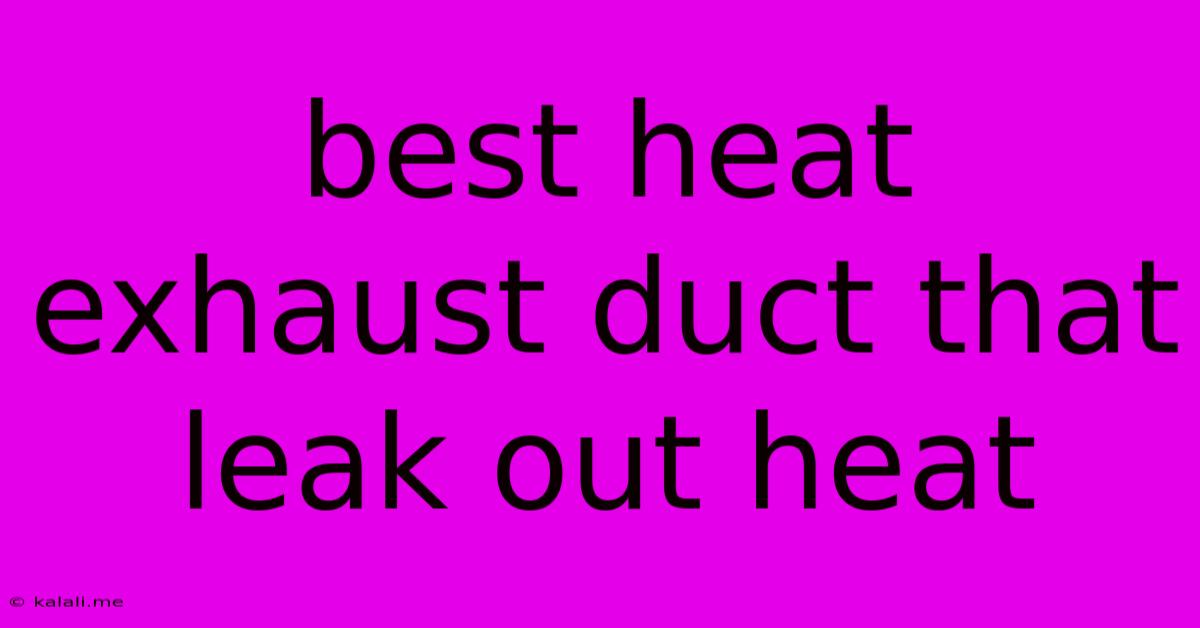Best Heat Exhaust Duct That Leak Out Heat
Kalali
Jun 04, 2025 · 3 min read

Table of Contents
Best Heat Exhaust Ducts That Leak Out Heat: A Comprehensive Guide
Meta Description: Finding the best heat exhaust duct that effectively vents heat is crucial for efficiency and safety. This guide explores top duct types, installation tips, and troubleshooting leaky ducts to optimize your system.
Heat exhaust ducts are critical components in various applications, from industrial machinery to residential ventilation systems. Their primary function is to safely and efficiently remove unwanted heat, improving performance and preventing overheating. However, a leaky duct significantly compromises this function, wasting energy and potentially causing safety hazards. This article explores the best heat exhaust duct options, focusing on those designed to minimize heat leakage and maximize efficiency. We'll also delve into identifying and fixing leaks in existing systems.
Understanding Heat Exhaust Duct Types and Their Leakage Potential
Several duct types are used for heat exhaust, each with its own strengths and weaknesses concerning heat leakage:
-
Flexible Ducting (Aluminum Foil): This affordable option is lightweight and easy to install, making it popular for DIY projects. However, its flexible nature makes it prone to kinks and creases, creating points where heat can escape. Poorly sealed connections are also common culprits for leakage. It's generally less efficient for high-temperature applications.
-
Rigid Metal Ducting (Galvanized Steel or Aluminum): Rigid ducting offers superior durability and better heat retention than flexible ducting. Properly sealed joints minimize heat leakage significantly. Galvanized steel is more robust and suitable for higher temperatures, but it can be heavier and more challenging to install. Aluminum offers a lighter alternative.
-
Insulated Ducting: Insulated ducting, often constructed with fiberglass or mineral wool insulation wrapped in aluminum foil, is designed specifically to minimize heat loss. This type is highly recommended for applications where heat efficiency is paramount. The insulation layer drastically reduces heat transfer to the surrounding environment.
-
High-Temperature Ducting (Stainless Steel): For extremely high-temperature applications, stainless steel ducting is essential. Its resilience to heat and corrosion makes it ideal for industrial settings or specialized heating systems. Proper installation is crucial to maintain its integrity and prevent leaks.
Identifying and Fixing Leaks in Your Heat Exhaust System
A leaky heat exhaust duct can lead to reduced efficiency, increased energy costs, and potential safety risks. Here's how to identify and address leaks:
-
Visual Inspection: Carefully examine the entire duct system for visible cracks, holes, or loose connections. Pay close attention to bends and joints, where leaks often occur.
-
Smoke Test: A smoke test can pinpoint subtle leaks. Introduce a small amount of non-toxic smoke into the duct system and observe its escape points. This method is particularly effective for identifying smaller leaks.
-
Infrared Thermography: For a more sophisticated approach, infrared thermography can reveal heat leaks even in hard-to-see areas. This technology creates a thermal image highlighting temperature variations, making it easy to spot heat escaping through leaks.
-
Repairing Leaks: Once leaks are identified, repair them using appropriate sealant or patching material. For minor leaks, high-temperature sealant may suffice. Larger holes or damaged sections may require replacement of the affected duct segment. Ensure all connections are properly sealed to prevent future leaks.
Choosing the Right Heat Exhaust Duct: Key Considerations
Selecting the right heat exhaust duct involves considering several factors:
-
Temperature: The operating temperature of your system determines the appropriate duct material. High-temperature applications require robust materials like stainless steel or properly insulated ducting.
-
Airflow: The required airflow volume influences duct size and design. Adequate airflow prevents back pressure and ensures efficient heat removal.
-
Length and Configuration: The length and complexity of the ductwork affect heat loss. Minimize unnecessary bends and maintain a streamlined layout for optimal efficiency.
-
Budget: Different duct types vary in cost. Weigh the initial investment against long-term energy savings and maintenance costs.
-
Installation: Consider the complexity of installation for each duct type. Some may require professional installation, while others are suitable for DIY projects.
By carefully considering these factors and employing proper installation techniques, you can ensure your heat exhaust system operates efficiently and safely, minimizing heat loss and maximizing performance. Remember, a well-maintained heat exhaust system contributes significantly to energy efficiency and overall system longevity.
Latest Posts
Latest Posts
-
Operands Could Not Be Broadcast Together With Shapes
Jun 06, 2025
-
Cat Keeeps Sleeping On The Floor
Jun 06, 2025
-
Knocked It Out Of The Park
Jun 06, 2025
-
Going Out On A Limb Meaning
Jun 06, 2025
-
How To Clear A Cloudy Pool
Jun 06, 2025
Related Post
Thank you for visiting our website which covers about Best Heat Exhaust Duct That Leak Out Heat . We hope the information provided has been useful to you. Feel free to contact us if you have any questions or need further assistance. See you next time and don't miss to bookmark.